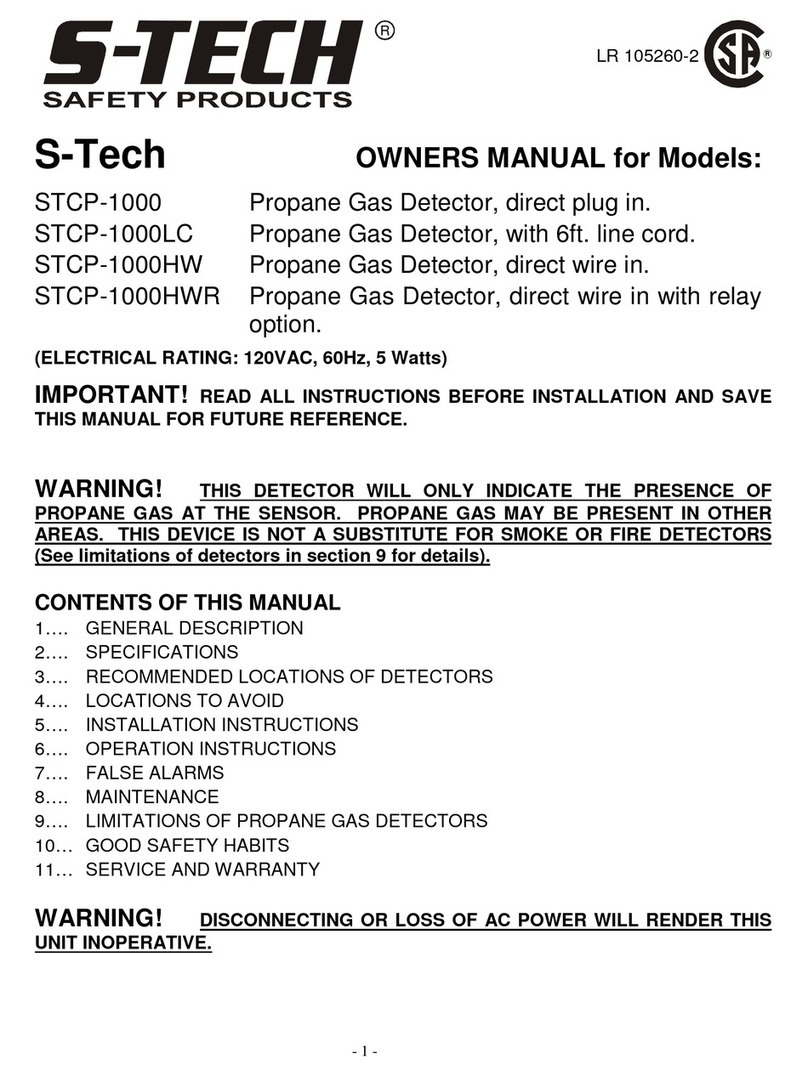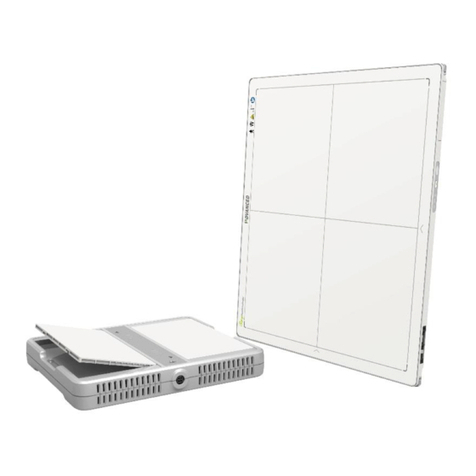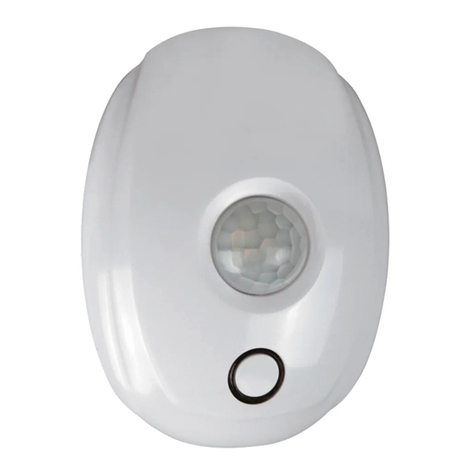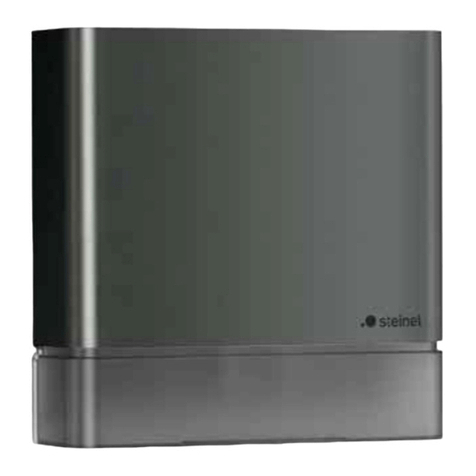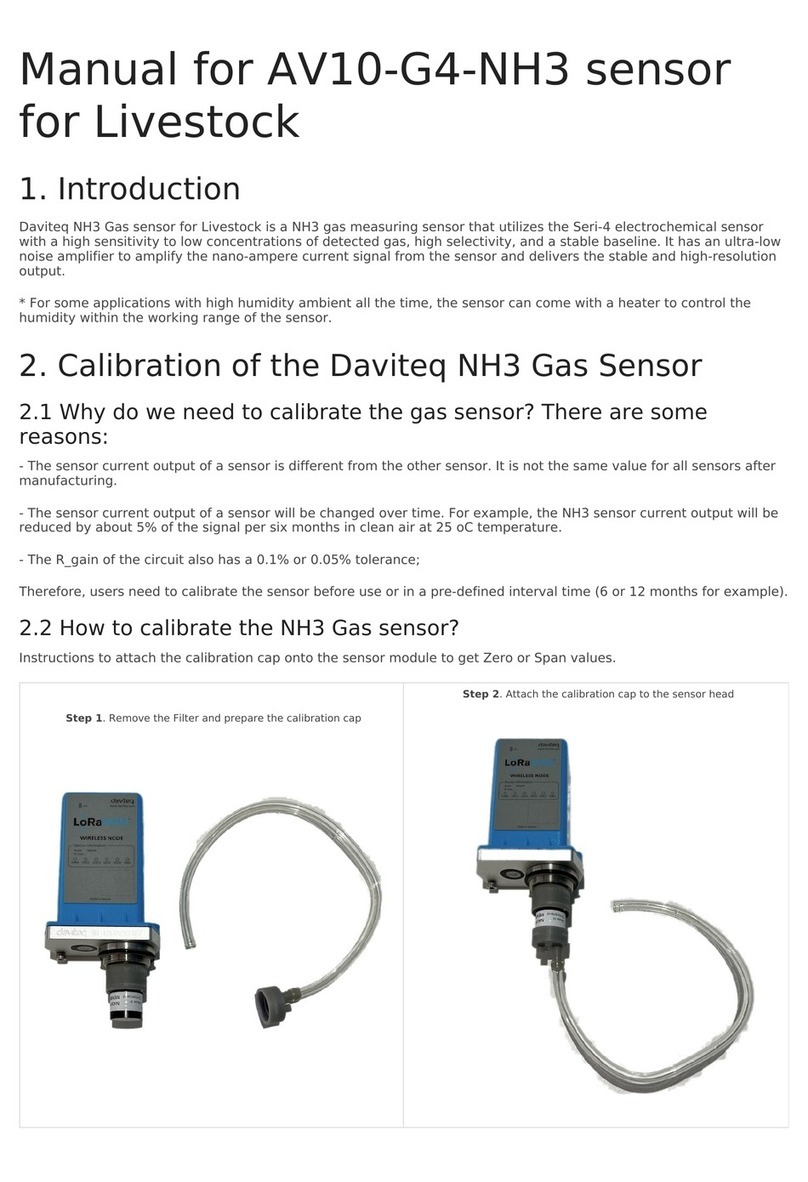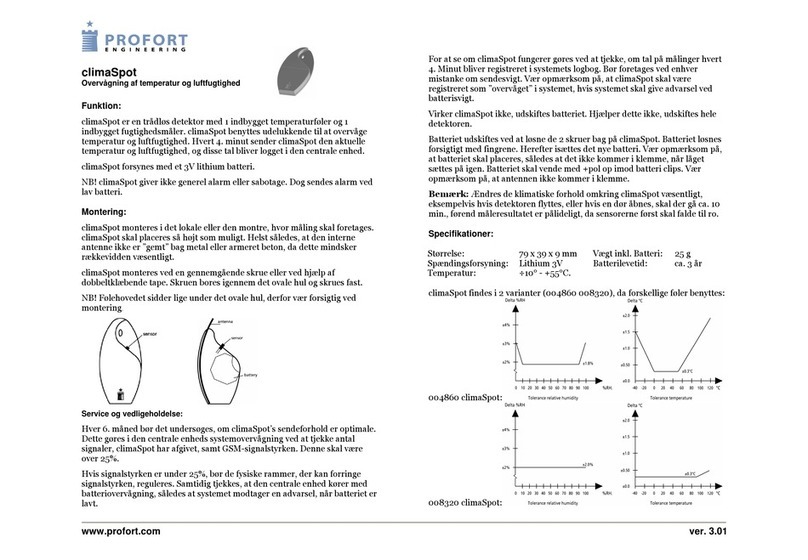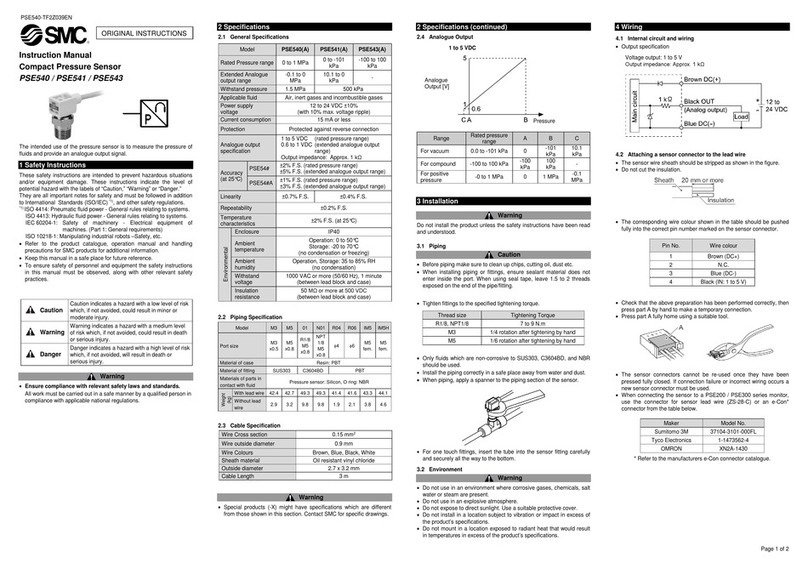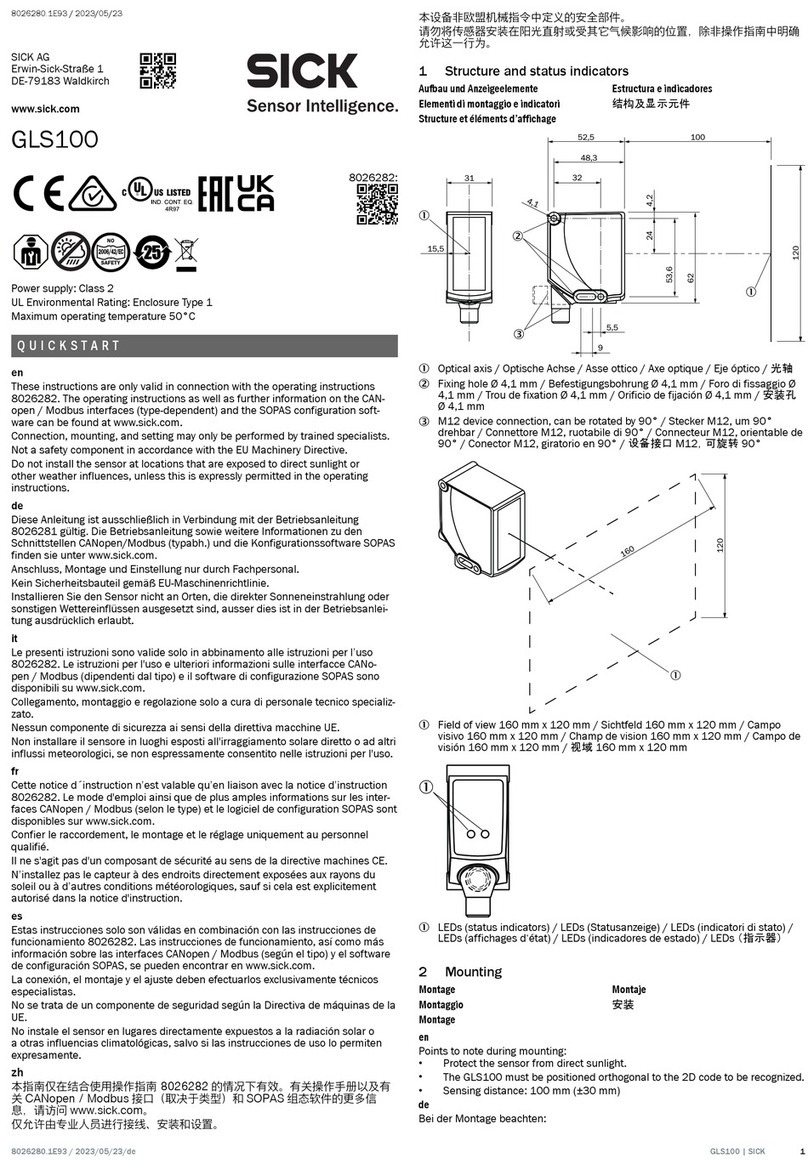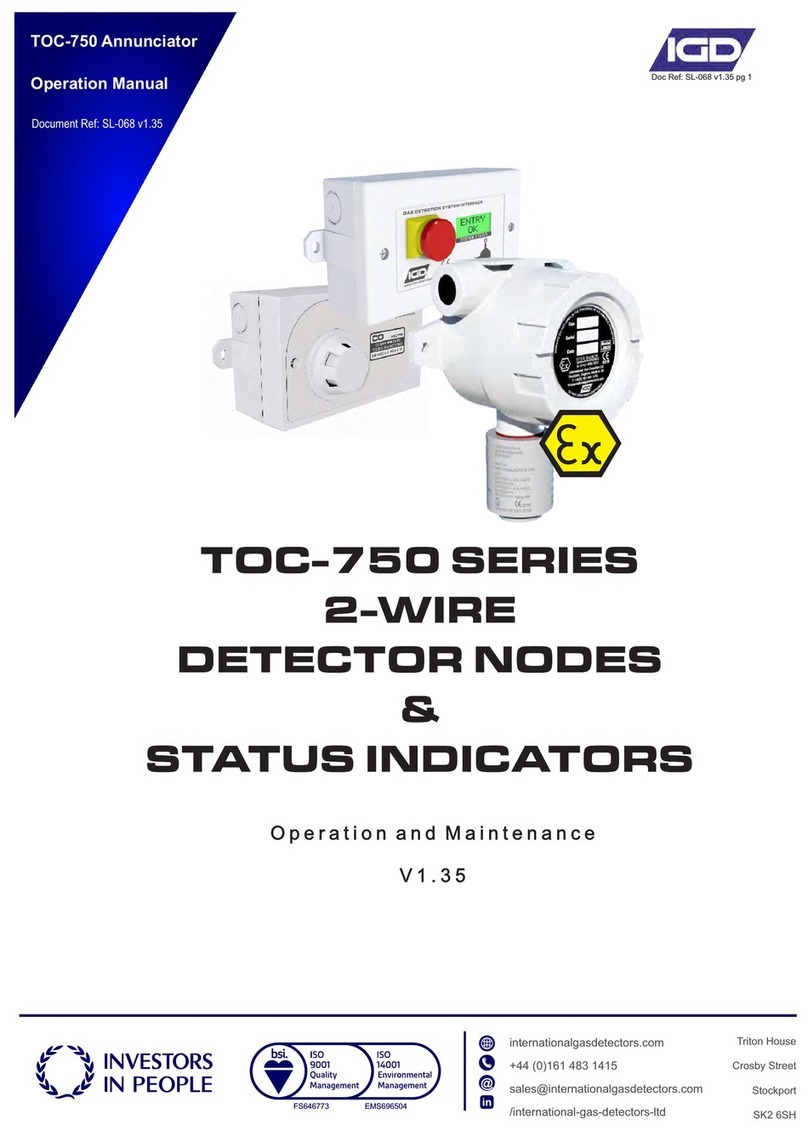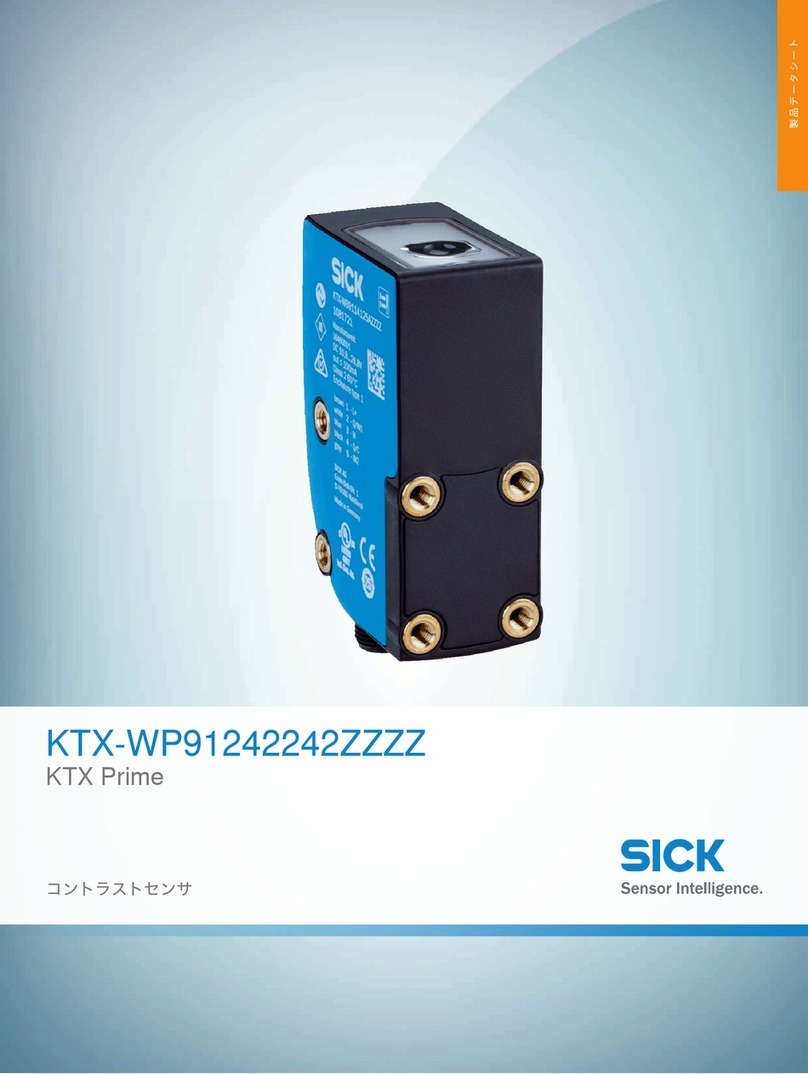S-Tech STCH-1000 User manual

- 1 -
OWNERS MANUAL for Models:
E163293
RESIDENTIAL GAS DETECTOR
STCH-1000 Natural (Methane) Gas Detector, direct plug
in.
STCH-1000LC Natural (Methane) Gas Detector, with 6ft.
line cord.
STCH-1000HW Natural (Methane) Gas Detector, direct wire
in.
STCH-1000HWR Natural (Methane) Gas Detector, direct wire
in with relay option.
(ELECTRICAL RATING: 120VAC, 60Hz, 5 Watts)
PSM-011 Natural (Methane) Gas Detector, 12 VDC
direct wire in with relay.
(ELECTRICAL RATING: 12VDC, 5 Watts)
IMPORTANT! READ ALL INSTRUCTIONS BEFORE INSTALLATION AND SAVE
THIS MANUAL FOR FUTURE REFERENCE.
WARNING!
THIS DETECTOR WILL ONLY INDICATE THE
PRESENCE OF NATURAL (METHANE) GAS AT THE SENSOR. NATURAL
(METHANE) GAS MAY BE PRESENT IN OTHER AREAS. THIS DEVICE IS NOT A
SUBSTITUTE FOR SMOKE OR FIRE DETECTORS (See limitations of detectors in
section 9 for details).
R
O

- 2 -
CONTENTS OF THIS MANUAL
1…. GENERAL DESCRIPTION
2…. SPECIFICATIONS
3…. RECOMMENDED LOCATIONS OF DETECTORS
4…. LOCATIONS TO AVOID
5…. CHEMICALS TO AVOID
6…. INSTALLATION INSTRUCTIONS
7…. OPERATION AND TESTING
8…. FALSE ALARMS
9…. MAINTENANCE
10…
LIMITATIONS OF NATURAL (METHANE) GAS DETECTORS
11…
GOOD SAFETY HABITS
12…
SERVICE AND WARRANTY
WARNING! DISCONNECTING OR LOSS OF AC POWER (OR DC POWER IN
MODEL PSM-011) WILL RENDER THIS UNIT INOPERATIVE.
1. GENERAL DESCRIPTION
The natural (methane) gas detector provides an early residential warning of the
presence of explosive natural (methane) gas and is factory calibrated to sound an
alarm that meets UL1484 standard. The L.E.L. (Lower Explosive Level) of natural
(methane) gas is 5% in volume and the alarm level of this detector is set at 10 – 25%
of the L.E.L. (Lower Explosive Level).
When the alarm is triggered the red light and buzzer will stay on for a minimum of 5
minutes. If natural (methane) gas levels persist beyond the calibrated level, the
detector will continue to alarm until the natural (methane) gas is cleared. See
OPERATION section for further information.
There have been many cases of serious injuries and damages reported that were
caused by natural (methane) gas leak explosions.
IMPORTANT! READ ALL OPERATION INSTRUCTIONS CAREFULLY.
FAMILIARIZE YOUR FAMILY WITH THE ALARM SIGNAL AND WHAT TO DO IN
THE EVENT OF AN ALARM.

- 3 -
2. SPECIFICATIONS
METHANE ALARM LEVEL
POWER SOURCE
10 – 25% L.E.L.
120VAC, 60Hz, 5 WATTS (FOR MODELS
STCH-1000, STCH-1000LC, STCH-
1000HW, STCH-1000HWR)
12VDC, 5 WATTS (FOR MODEL PSM-
011)
OPERATING TEMPERATURE
ALARM SOUND LEVEL
MINIMUM ALARM TIME
DETECTION FREQUENCY
RELAY RATED INDUCTIVE LOAD
RELAY MAX. SWITCHING POWER
32°F (0°C) TO 104°F (40°C)
85 dB AT 10 FEET
5 MINUTES
SAMPLING EVERY SECOND
0.2A at 125VAC; 1A at 30VDC
25VA, 30W
3. RECOMMENDED LOCATIONS OF DETECTORS:
•Install at least one natural (methane) gas detector on every floor level (see Figure
1).
•Install the detector close to every place that gas operated appliances are installed
(see Figure 1).
•Since natural (methane) gas is lighter than air (1:0.56), the greatest concentration
of gas will be immediately under the ceiling. Mount detectors on the wall with the
top edge of the detector at a minimum of 6” (15cm) and a maximum of 12” (30.5
cm) below the ceiling, and at least 2 feet (60.1 cm) from any corner (see Figure 2).
•If the ceiling is sloped or higher than 8.5 feet (2.6 m), please ask your local Gas
Company for advice about proper installation.
BEDROOM
BEDROOM
KITCHEN
DINNING
LIVING ROOM
BEDROOM
+
+
BEDROOM BEDROOM
BEDROOM
+
+
+
Detector placement
for minimum protection.
Additional detector
location for added protection.
FIGURE 1
Never Here
Side Wall
Ceiling
FIGURE 2
Acceptable Here
Dead Air
Space
12 IN
6 IN
6 IN
GAS
HEATER
DRYER
+
+
GAS OVEN

- 4 -
4. WARNING!
LOCATIONS TO AVOID:
•IN AN AREA WHERE THE TEMPERATURE MAY FALL BELOW 32°F (0°C) OR
RISE ABOVE 104°F (40°C)
•IN FRONT OF FORCED AIR DUCTS USED FOR HEATING AND AIR
CONDITIONING, NEAR CEILING FANS, OR OTHER HIGH AIR FLOW AREAS.
•DIRECTLY ABOVE ANY GAS APPLIANCE.
•IN CLEANING SUPPLY ROOMS: CHEMICALS USED IN HOUSEHOLD
CLEANING AND PAINTING SUPPLIES CAN CAUSE NUISANCE ALARMS.
•IN HAZARDOUS LOCATIONS: THIS DETECTOR IS NOT SUITABLE FOR
INSTALLATION IN A HAZARDOUS LOCATION, AS DEFINED IN THE NATIONAL
ELECTRICAL CODE.
5. WARNING!
CHEMICALS TO AVOID:
DO NOT EXPOSE THE DETECTOR TO CHEMICALS THAT WILL DEGRADE THE
SENSOR OR CAUSE PERMANENT DAMAGES.
•SILICONES FOUND IN LUBRICANTS, COSMETICS, AND CLEANING
PRODUCTS
•ORGANO-METALLIC COMPOUNDS FOUND IN SOME FUELS
•ACETYLENE FOUND IN OXY-FUEL WELDING
6. INSTALLATION INSTRUCTIONS:
NOTE!
REVIEW SECTION 3, RECOMMENDED LOCATIONS OF DETECTORS
AND SECTION 4, LOCATIONS TO AVOID, PRIOR TO INSTALLING YOUR
DETECTOR.
The proper power for the STCH-1000 series natural (methane) gas detectors is 120
volt single phase, supplied from a non-switchable circuit which is not protected by a
ground fault interrupter.
CAUTION!
TURN OFF THE MAIN POWER TO THE CIRCUIT BEFORE
WIRING THE DETECTORS STCH-1000HW and STCH-1000HWR.
STCH-1000HW and STCH-1000HWR should be installed on a U.L. listed or
recognized junction box. All wiring should be performed by a licensed electrician.
a. WIRING REQUIREMENTS
Installation of STCH-1000:
The model STCH-1000 is a direct plug in unit. Be sure that the outlet on which
you install the detector is not controlled by a switch and that the detector is not
obstructed by drapes etc.

- 5 -
Installation of STCH-1000LC:
Model STCH-1000LC is designed to be wall mounted. It has an attached 6-foot
line cord. Be sure that the outlet into which you plug the detector is not controlled
by a switch and that the detector is not obstructed by drapes etc.
Slide the mounting plate to the right to remove from the back of detector. Using
the enclosed screws and anchors install the mounting plate on the wall 5 to 6 feet
above the floor within cord reach of the outlet. Install the detector back on the
mounting plate and slide to the left to lock the detector in place.
Installation of STCH-1000HW:
STCH-1000HW has one set of AC power wire harness. For the AC Power Quick
Connector wiring connection, the black wire is connected to 120VAC Hot line, and
the white wire is connected to the Neutral line (see Figure 3A).
Installation of STCH-1000HWR:
STCH-1000HWR has two sets of wire harness, AC power and relay. For the AC
Power Quick Connector wiring connection, the black wire is connected to 120VAC
Hot line, and the white wire is connected to the Neutral line (see Figure 3A).
Installation of PSM-011:
PSM-011 has two sets of wire harness, DC power and relay. For the DC Power
Quick Connector wiring connection, the red wire is connected to 12VDC, and the
black wire is connected to 0VDC (see Figure 3B).
Connections on the relay:
The Relay Quick Connector has three wires to serve as the relay connections (see
Figure 3C). Green wire is Common (COM) contact, blue wire is Normally Open
(NO) contact, and yellow wire is Normally Closed (NC). Connect the blue wire
(NO) to the supply side of the device for switching it on when the detector sounds,
instead of the yellow wire (NC) for switching the device off.
LIVE
(120VAC)
FUSE OR CIRCUIT BREAKER
NEUTRAL
STCH-1000HW
WHITE
(NEUTRAL)
BLACK
(AC HOT)
STCH-1000HWR
A) 120VAC Wire Harness
0VDC
WIRE
12VDC
WIRE
RED
(12VDC)
BLACK
(0VDC)
PSM-011
B) 12VDC Wire Harness
C) Relay Wire Harness
YELLOW (NC)
BLUE (NO)
GREEN (COM)
Relay Quick Connector
RELAY CONTACTS
RATED 1A 30VDC
AC Power
Quick
Connector
WHITE
(NEUTRAL)
BLACK
(AC HOT)
AC Power
Quick
Connector
DC Power
Quick
Connector
STCH-1000HWR / PSM-011
FIGURE 3: WIRE HARNESS

- 6 -
b. MOUNTING INSTRUCTIONS
•Remove the mounting plate from the back of detector (slide to the unlock
position to remove).
•Select the proper detector location as described in section 3.
•Connect the Quick Connector for power and relay as described in the WIRING
REQUIREMENTS.
•For models STCH-1000HW and STCH-1000HWR, secure the mounting plate
to the electrical box using the appropriate holes (see Figure 4). For model
PSM-011, which is designed to be wall mounted, use the enclosed screws and
anchors to fasten the mounting plate on the wall 5 to 6 feet above the floor.
•Pull the Quick Connector through the center hole in the mounting plate.
•Plug the mating halves of Quick Connector with the same color of wires
together.
•Slide the detector on the mounting plate to the lock position.
•Turn on the power and the green POWER ON indicator should be lit for
receiving power.
After installation, TEST your detector by pressing and holding the
TEST/RESET
button for several seconds. Complete instructions regarding testing are outlined
in section 7.
FIGURE 4: ELECTRCAL BOXES AND MOUNTING PLATE
MOUNTING PLATE ORIENTATION
FOR W ALL MOUNTING
“B”
“A”
“C”
“B”
“C”
“A”
Octagonal
Electrical Box
(Use diagonal
holes: Set “A”
or Set “B”)
Rectangular
Electrical Box
(Use holes
Set “C”)
Rectangular
plaster ring
Circular
plaster ring
UP

- 7 -
7. OPERATION, TESTING
a. POWER ON: When 120VAC power (for models STCH-1000, STCH-1000LC,
STCH-1000HW, STCH-1000HWR) or 12VDC power (for model PSM-011) is
applied, the natural (methane) gas detector requires a warm-up period to stabilize
the sensor element of approximately 3 minutes. The green LED will flash during
this period. When the green LED lights on solidly, the detector begins to detect
natural (methane) gas concentrations once a second.
b. TROUBLE CONDITION: The internal micro-controller continuously monitors the
sensor and other critical components. If an internal failure of any of these
components occurs, the detector will flash the red LED and buzzes four times
every 30 seconds. Please see Section 12 for information regarding service.
c. LIFE MONITOR (END-OF-LIFE) CONDITION: The natural (methane) gas sensor
has life expectancy of 5 years. The micro-controller monitors the total time that
the detector is under power. After 5 years of service, the “End-of-Life” signal will
be activated; the detector will flash the red LED and beep once in every 30
seconds, indicating that sensor life has expired and the detector should be
replaced.
d. ALARM MODE: When natural (methane) gas concentration exceeds calibrated
level (10-25% L.E.L.), the detector will sound ”beep-beep” and turn on the red
LED. If this dangerous condition lasts for 4 seconds, the natural (methane) gas
detector will latch on alarm mode for 5 minutes with the red LED turning on and
the buzzer sounding continuously. During this 5 minutes period, the detector will
cease sensing gas concentrations and the green LED will flash to indicate the
same condition in warm-up. If the natural (methane) gas level still persists beyond
the calibrated level after 5 minutes, the detector will continue to alarm until the
natural (methane) gas clears.
e. TESTING:
IMPORTANT!
TEST MONTHLY TO ENSURE PROPER
OPERATION.Test the detector by pushing the
TEST/RESET
button on the cover
and hold it down. This will simulate a concentration of a natural (methane) gas
exceeding the safety level. If all the electronic circuit and buzzer module are
working, the detector will turn on the red LED and sound the buzzer continuously.
Do not try to test this detector in any other way.
If the detector does not respond properly, check the fuse or circuit breaker
supplying power to the detector circuit. If the detector still does not sound the unit
may be defective or have other failure and should be returned for service (see
section 12).
An erratic or low sound coming from your detector may indicate a defective
detector, and it should be returned for service (see section 12).

- 8 -
f. RESET: The detector will automatically reset itself when the natural (methane) gas
which caused the alarm has cleared. The detector will however alarm for at least
5 minutes if it is not manually reset. You can also silence the detector by pushing
the
TEST/RESET
button. The detector will need 30 seconds to reset its system and
sensor as in the warm-up period, the green LED will flash until it is ready to detect
the presence of natural (methane) gas. If natural (methane) gas is still present,
the detector will alarm again.
g. RELAY ACTION (for STCH-1000HWR and PSM-011): The relay provides
normally open (blue wire), and normally closed (yellow wire) contacts to activate
the devices such as central panel, extra buzzer, additional alarm lamp, control
switch of gas source, etc. The relay will be activated when detector sounds for
going off alarm and testing. Be sure not to exceed the relay maximum contact
ratings.
8. FALSE ALARMS
This detector responds to the presence of natural (methane) gas. It does not detect
smoke. If the detector does alarm, get out of the house and call the Gas
Company. If no problem is found by the Gas Company, check to see if one of the
reasons listed in section 4 may have caused the alarm.
Some solvents used in chemical cleaning agents, paints, varnishes and the furniture
refinishing process, and some propellants used in aerosol hair spray and air-
fresheners can cause the detector to alarm if they are used in close proximity to the
detector for extended periods of time. Gasoline or other flammable liquids stored in
open containers near the detector may also cause the detector to alarm. Never store
flammable liquids in open containers.
IF YOU HAVE BEEN AWAY FROM HOME and you return to find your alarm
sounding, DO NOT ENTER YOUR HOME. Call the Gas Company from a
neighbor’s home. DO NOT RE-ENTER YOUR HOME FOR ANY REASON UNTIL
YOU HAVE BEEN ASSURED THAT IT IS SAFE TO DO SO.
NOTE: A newly installed detector may have picked up various fumes or gases that
include natural (methane) gas during transit and storage. This accumulation of
contamination can cause the detector to go into the alarm mode during the initial
power up. You can choose to do nothing and the detector will stop sounding in a few
minutes, or you can press the
TEST/RESET
button, which will stop the alarm
immediately. It may be necessary to reset the unit several times to fully clear the
sensor of the accumulated contamination.

- 9 -
9. MAINTENANCE: CLEANING YOUR DETECTOR
You can clean your detector by using a vacuum cleaner hose and vacuuming around
the openings on the detector. The outside of the detector can be wiped with a damp
cloth. NO chemical detergent should be used to clean this detector. After cleaning,
test your detector by using the TEST/RESET button and check that the green
LED is on.
10.LIMITATIONS OF NATURAL (METHANE) GAS DETECTORS
Natural (Methane) gas detectors are devices that can provide an early warning of the
presence of natural (methane) gas at a reasonable cost. However, detectors have
sensing limitations and may not always sound a warning of the presence of natural
(methane) gas. STCH-1000 series A.C. powered detectors will not operate if the A.C.
power has been cut off, such as by an electrical fire, a tripped circuit breaker or an
open fuse. These detectors must be tested regularly to make sure that they are
receiving power and operating properly. Detectors cannot sense natural (methane)
gas that does not reach the detector and therefore, detectors may not detect natural
(methane) gas, which is in a different area of a home. If the detector is located on a
different level of the home or on the other side of a closed door, it may not waken a
sound sleeper. The use of drugs and alcohol may impair one’s ability to hear the
alarm. If you have a multi-level home, install detectors on each level of the home. If
the detector is installed in a hallway and the bedroom doors are kept closed at night,
install a detector in each bedroom.

- 10 -
11.GOOD SAFETY HABITS:
a. DEVELOP AND PRACTICE A PLAN OF ESCAPE:
•Make a floor plan indicating all doors and windows and at least two (2) escape
routes from each room. Second story windows may need a rope or chain
ladder.
•Have a family meeting and discuss your escape plan, showing everyone what
to do in case the alarm sounds.
•Determine a place outside your home where you can all meet if an alarm
occurs.
•Familiarize everyone with the sound of the alarm and train them to leave your
home when they hear it.
•Practice an escape drill at least once every six months. Practice allows you to
test your plan before an emergency. You may not be able to reach your
children in an emergency, so it is important that they know what to do.
b. WHAT TO DO WHEN THE ALARM SOUNDS:
•Leave immediately by your escape plan. Every second counts, so don’t waste
time getting dressed or picking up valuables.
•Once outside go to your selected meeting place and make sure everyone is
there.
•Call the Gas Company from your neighbor’s home – not from yours!
•Don’t return to your home until the problem has been corrected or the officials
say that it is all right to do so.

- 11 -
12.SERVICE AND WARRANTY:
If after reviewing this manual you feel that your natural (methane) gas detector is
defective in any way, do not tamper with the unit. Return it for servicing.
NOTE:
DO NOT TRY TO REPAIR THIS DETECTOR YOURSELF.
TWO YEAR LIMITED WARRANTY
Patrick Plastics Inc. provides a 2 (two) years limited warranty on the natural
(methane) gas detector. If the purchaser discovers that the unit is defective, she/he must
send the natural (methane) gas detector prepaid with proof of date of purchase and a
check in the amount of $5.00 payable to Patrick Plastics Inc. (to cover the cost of
shipping and handling) to Warranty Service Dept., Patrick Plastics Inc., 1495 Denison
Street, Markham, Ontario L3R 5H1 Canada. Upon receipt of same, the obligation of
Patrick Plastics Inc. under this warranty is limited to repairing or replacing any parts
which it finds under normal use, to be defective in material, workmanship or design and
returning same to the customer. This warranty shall not apply to any natural (methane)
gas detectors that have been opened, damaged, modified, abused or altered in anyway
after the date of purchase, or if it fails to operate due to improper maintenance or
inadequate A.C./ D.C. electrical power.
THE LIABILITY OF PATRICK PLASTICS INC. OR OF ANY OF ITS PARENT OR
SUBSIDIARY CORPORATIONS ARISING FROM THE SALE OF THIS NATURAL
(METHANE) GAS DETECTOR OR UNDER THE TERMS OF THIS LIMITED
WARRANTY SHALL NOT IN ANY CASE EXCEED THE COST OF THE
REPLACEMENT OF THE NATURAL (METHANE) GAS DETECTOR. IN NO CASE
SHALL PATRICK PLASTICS INC. OR ANY OF ITS PARENT OR SUBSIDIARY
CORPORATIONS BE LIABLE FOR CONSEQUENTIAL LOSS OR DAMAGES
RESULTING FROM THE FAILURE OF THE NATURAL (METHANE) GAS DETECTOR
OR FOR THE BREACH OF THIS OR ANY OTHER WARRANTIES, EXPRESSED OR
IMPLIED, EVEN IF THE LOSS OR DAMAGE IS CAUSED BY THE COMPANY’S
NEGLIGENCE OR FAULT.
Since some states do not allow limitations on the duration of an implied warranty or do
not allow the exclusions or limitations of incidental or consequential damages, the above
limitations or exclusions may not apply to you. While this warranty gives you specific
legal rights, you may also have other rights which vary from state to state.
The above warranty may not be altered by any agent, representative, dealer or
employee.
PATRICK PLASTICS INC.
1495 Denison Street
Markham, ON
L3R 5H1 Canada
For all enquires, Call 1-800-203-7987 (US and CANADA)
905-660-9066 (Metro Toronto, CANADA)
240-1088-04 5/11/2017
This manual suits for next models
3
Table of contents
Other S-Tech Security Sensor manuals
Popular Security Sensor manuals by other brands
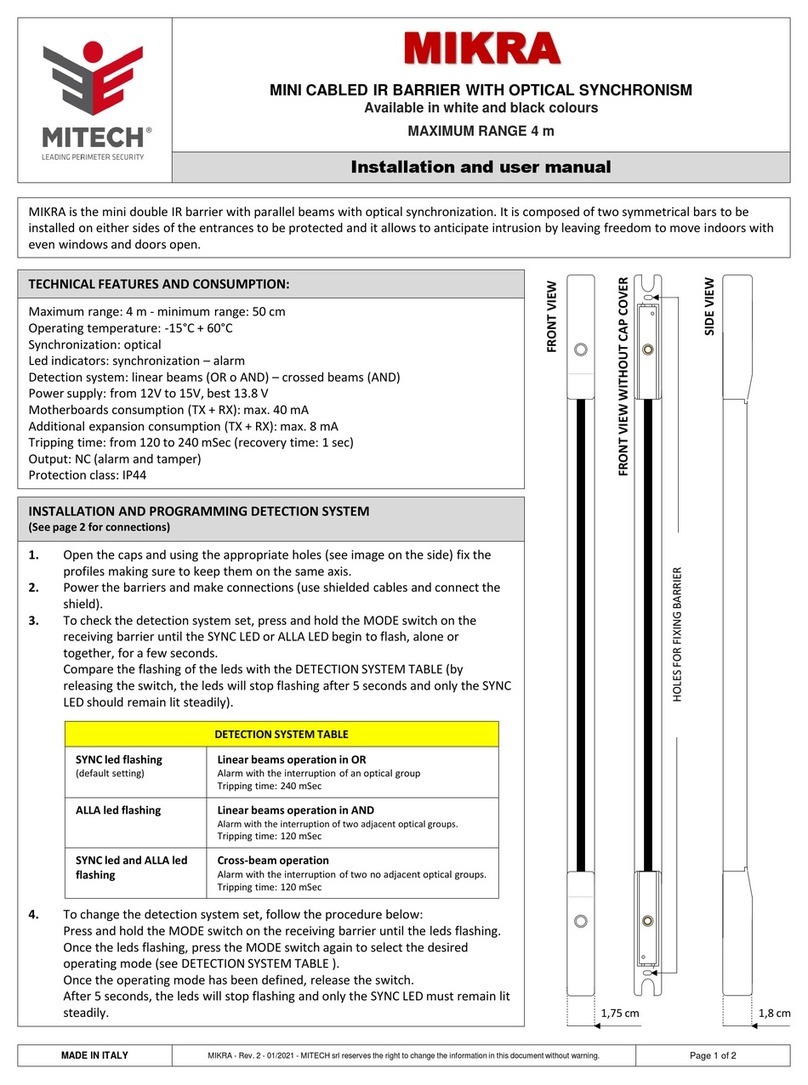
MITECH
MITECH MIKRA Installation and user manual
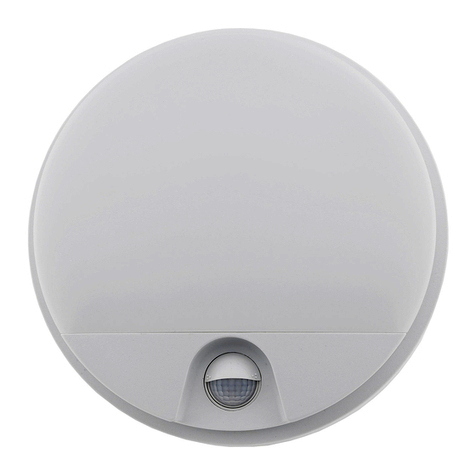
ChiliTec
ChiliTec 23090 Operation manual
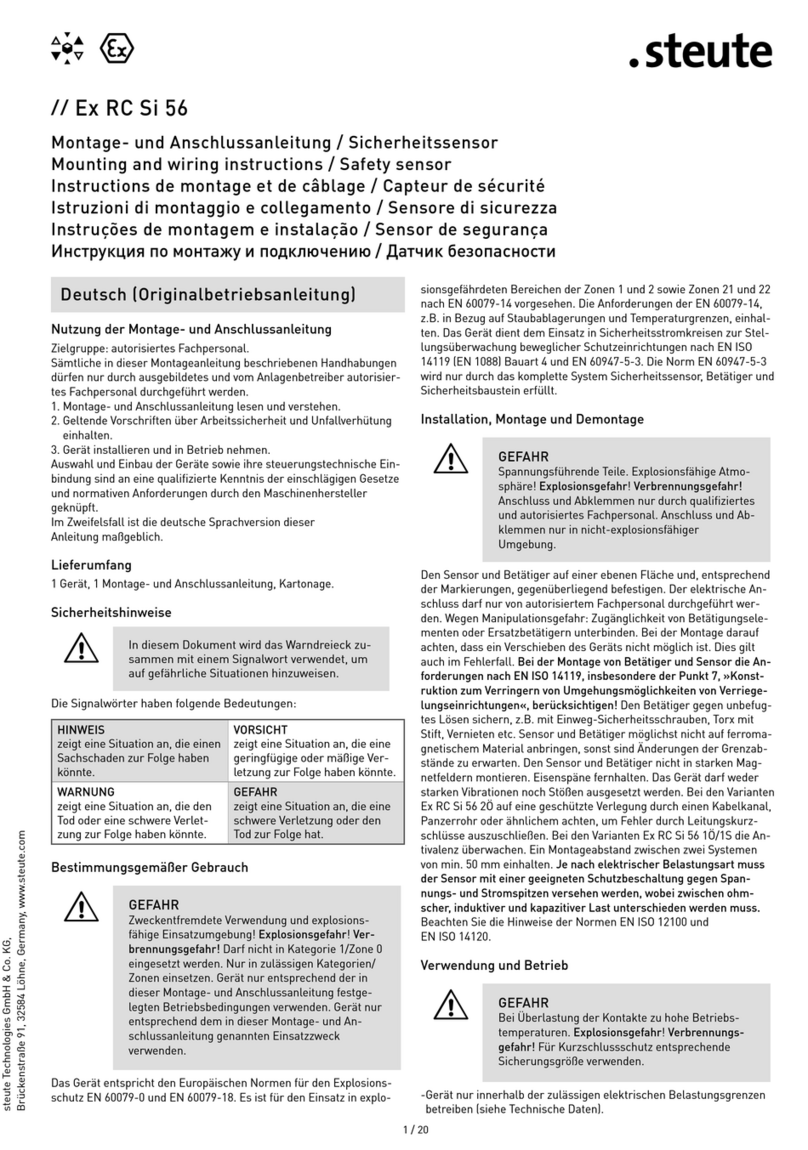
steute
steute EE RC Si 56 Series Mounting and wiring instructions
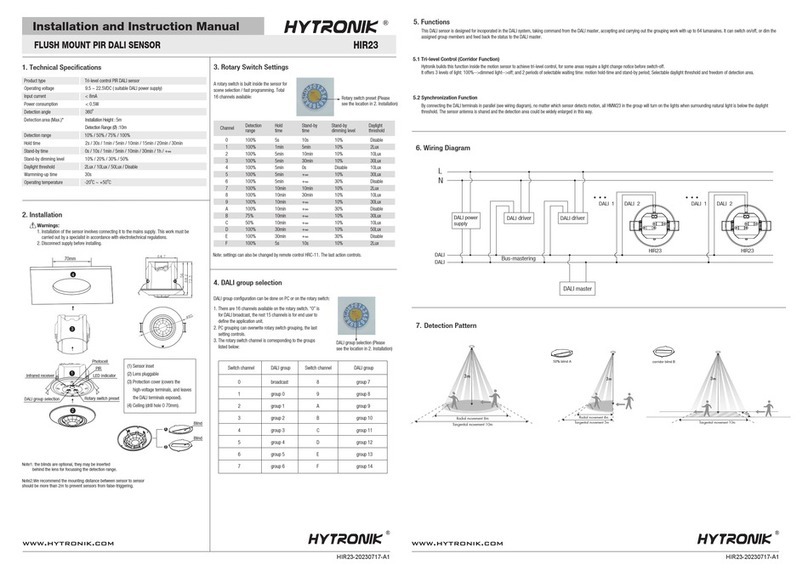
Hytronik
Hytronik HIR23 Installation and instruction manual
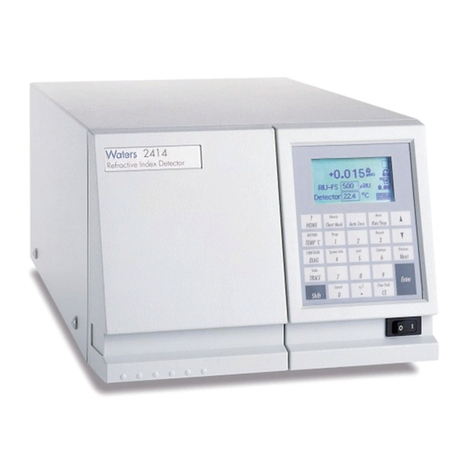
Waters
Waters 2414 Overview and maintenance guide
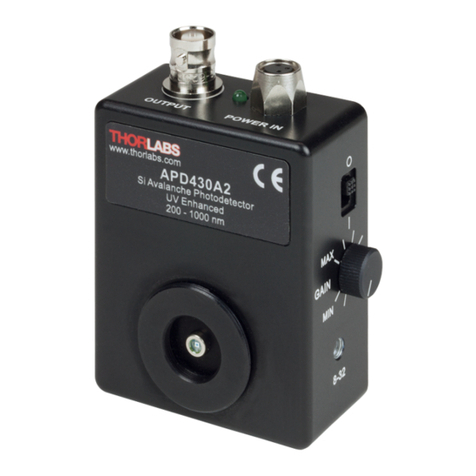
THORLABS
THORLABS APD430 Series Operation manual
